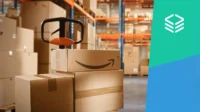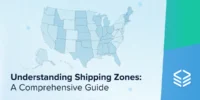Ecommerce retailers are constantly strategizing new ways to stay competitive as customer expectations continue to rise. Customers expect fast, seamless delivery, ideally with no extra costs or fees, which marketplace integration can facilitate. They also value the flexibility of shopping across channels, and choosing their preferred delivery method for every purchase they make. Whether it’s an in-store pickup or same-day delivery to their front door, shoppers want to maintain control over when and how they receive their shipments.
In response to this consumer behavior, an ecommerce trend that has been gaining steam is micro-fulfillment. So, what is micro-fulfillment and what are the pros and cons of this strategy?
Micro-fulfillment is the use of small, localized storage and fulfillment facilities that are in close proximity to the end customer to improve delivery times and reduce shipping costs. Though often used interchangeably with micro-warehousing, these are two separate concepts.
Micro-warehousing is a fulfillment process that doesn’t take place within traditional warehouse walls. Compared to other fulfillment solutions, it involves retailers reimagining how they are using their storefronts and storage spaces. When customers place orders online for in-store or curbside pickup, employees must pick these items from the shelves and place them in a holding area, such as storage lockers, to fulfill the order without disrupting store operations. Both micro-fulfillment and micro-warehousing are strategies to improve efficiency and reduce transportation time and costs tied to last mile logistics.
Benefits of micro-fulfillment
The core benefits of a micro-fulfillment strategy include inventory optimization, an improved last mile delivery experience for customers, and the flexibility to scale.
Localized data and inventory
A micro-fulfillment center enables retailers to optimally allocate inventory curated for the local market. With optimized inventory allocation based on customer analytics, brands can store and fulfill only the items most often purchased by consumers in a region, eliminating wasted storage space and stagnant inventory. Insights gleaned from order history and patterns can then be used to better forecast local product appetite and inventory needs. These customer insights can also inform inventory and network planning decisions as a brand scales, providing a lens into how metrics vary by region.
Improved last mile delivery
Statistics show last mile delivery costs account for 53% of the total cost of shipping. Storing and fulfilling orders close to customers greatly improves cost-effectiveness for retailers, while also meeting customer expectations for speedy delivery. The closer the fulfillment center is to where a customer base resides, the fewer disruptions to contend with due to shipping delays, weather events, or other disruptions that can happen at any point once goods leave the fulfillment center. Last mile considerations are a crucial aspect of developing a customer driven supply chain strategy.
Flexibility to scale
Though micro-fulfillment centers have less square footage than typical warehouses, they still provide companies the opportunity to grow. Micro-fulfillment centers are often less expensive to add to existing networks to complement a broad distribution strategy. Micro-fulfillment centers can help save on the outsize expense of leasing large distribution centers, while allowing for high-volume fulfillment where there is high customer demand. If fulfillment centers are part of a connected network, retailers benefit from the flexibility of using only the space they need, with room to scale up as needed.
Challenges of micro-fulfillment
With every innovation also comes challenges. Some of the potential drawbacks of micro-fulfillment include managing unpredictable consumer demand, replenishment overflow, and adapting to changing customer preferences.
Unpredictable consumer demand
Though data and customer analytics help to gauge predictive product demand, there are outlier situations (i.e. a global pandemic) that can shake up micro-fulfillment projections. The pandemic isn’t the only event causing unpredictability. Weather-based natural phenomena like tornadoes and wildfires can cause an unexpected surge in demand for necessities, or on the flip side, shut down fulfillment operations in certain areas, disrupting the inventory balance of micro-fulfillment centers. The economy, short-lived trend cycles, and the natural evolution of audiences can also affect inventory from year to year or even month to month, all of which can present a challenge.
Replenishment overflow
In addition to preventing out-of-stock inventory, overstocking can be a challenge due to the reduced storage space. With much smaller square footage compared to distribution warehouses, it is essential for inventory management to be as accurate as possible. The larger the product volumes, the greater the challenge for replenishment to meet the demands of the local consumers, and without fulfillment software that provides the real-time visibility needed to make smart decisions, replenishment can present a major challenge.
Changing customer preferences
Consumers appreciate choices, and may sometimes select various methods of fulfillment even when shopping from the same brand or retailer, which is why many lean on custom branded packaging to ensure a unified experience. Supporting omnichannel fulfillment options, like same-day delivery, in-store or curbside pickup, and actual in-store shopping, while wise from the customer experience perspective, can present a challenge for brands in terms of inventory allocation and replenishment. While customers appreciate the convenience of quick delivery, that benefit doesn’t mean much if the item is out of stock – another reason that real-time visibility is needed for accurate inventory management.
In today’s market, adopting the micro-fulfillment strategy is only one of the many ways to stay competitive. Every brand must tailor its approach based on how the company operates and what its goals are. Let us help you create an ecommerce fulfillment solution that works best for your specific needs. Get in touch with us today to learn more.
Sources:
- CB Insights. The Next Shipping & Delivery Battleground: Why Amazon, Walmart, & Smaller Retailers Are Betting On Micro-Fulfillment. https://www.cbinsights.com/research/micro-fulfillment-tech-shipping-retail/
- PWC. Shifting patterns: The future of the logistics industry. https://www.pwc.com/sg/en/publications/assets/future-of-the-logistics-industry.pdf
- LinkedIn. 5 Challenges of micro-fulfillment and How to Rethink Grocery Retail. https://www.linkedin.com/pulse/5-challenges-micro-fulfillment-how-rethink-grocery-retail-john-ripple/
- Business Insider. The challenges of last mile delivery logistics and the tech solutions cutting costs in the final mile. https://www.businessinsider.com/last-mile-delivery-shipping-explained






